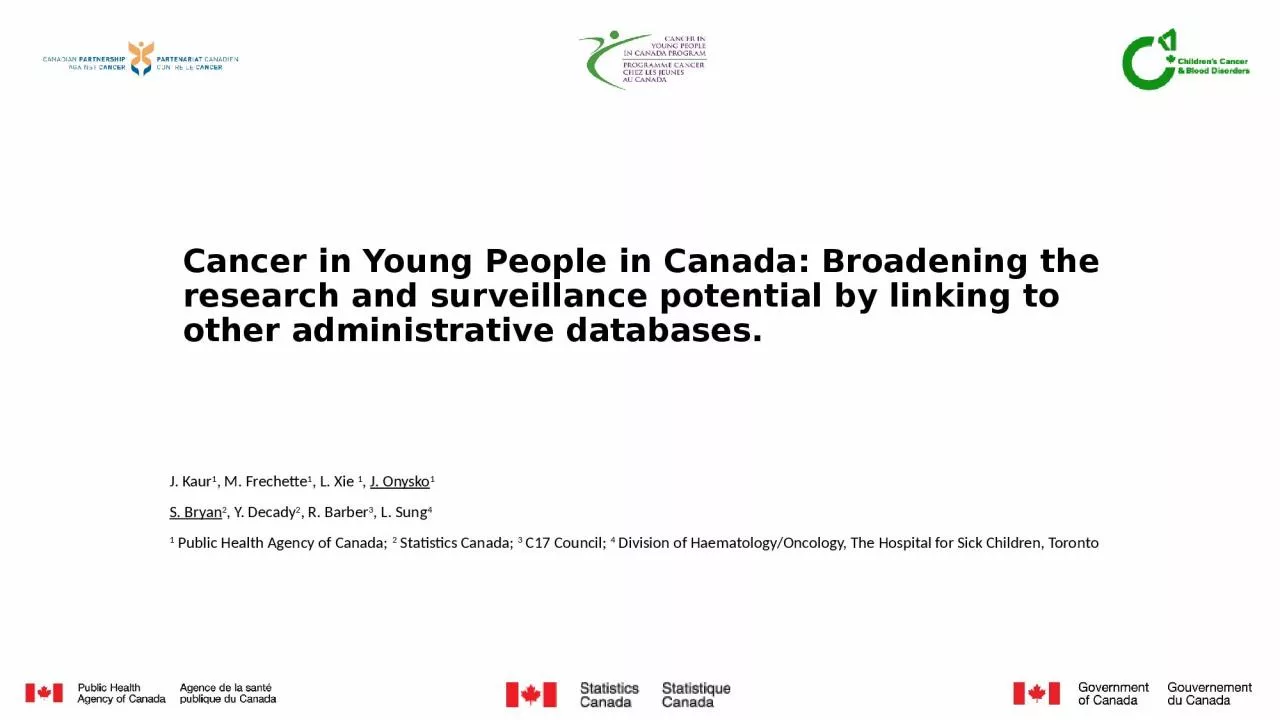

J Kaur 1 M Frechette 1 L Xie 1 J Onysko 1 S Bryan 2 Y Decady 2 R Barber 3 L Sung 4 1 Public Health Agency of Canada 2 Statistics Canada 3 C17 Council ID: 1035711
Download Presentation The PPT/PDF document "Cancer in Young People in Canada: Broade..." is the property of its rightful owner. Permission is granted to download and print the materials on this web site for personal, non-commercial use only, and to display it on your personal computer provided you do not modify the materials and that you retain all copyright notices contained in the materials. By downloading content from our website, you accept the terms of this agreement.
1. Cancer in Young People in Canada: Broadening the research and surveillance potential by linking to other administrative databases.J. Kaur1, M. Frechette1, L. Xie 1, J. Onysko1S. Bryan2, Y. Decady2, R. Barber3, L. Sung41 Public Health Agency of Canada; 2 Statistics Canada; 3 C17 Council; 4 Division of Haematology/Oncology, The Hospital for Sick Children, Toronto
2. OutlineOverview of the Cancer in Young People in Canada (CYP-C) databaseRecord linkage at Statistics CanadaLinkage plans: CYP-C to other administrative dataAccess to linked data for researchersResearch potential of the linked data
3. What is CYP-C?An enhanced cancer registry and research database focused on children aged <15 years AND diagnosed or treated in a Canadian pediatric cancer centreCYP-C database captures: Demographics (sex, date of birth, postal code, ethnicity)Diagnostic details (cancer type and stage, risk category)Treatment plans / details (chemo, surgery, transplant, trial participation)Dates (time intervals between events)Short/medium-term outcomes (5-year follow-up: relapse, complications, and survival)Longer-term health outcomes through data linkageLonger follow-up - survival, late effects, causes of death Canadian Vital Statistics: death databaseCIHI hospitalization data3
4. CYP-C – How it worksData are collected from the 17 pediatric oncology centres across Canada C17Ontario data provided by POGONIS are integrated into CYP-C. Data abstraction is obtained through chart review from each pediatric oncology centre by a Clinical Research Associate (CRA) at each centre.4Detailed information on eligible cases is collected from diagnosis through to five years post diagnosis.Contains over 16,595 cases (2001 - 2015)
5. Obtaining CYP-C dataApplication process: Go online: www.c17.caComplete a Research Proposal TemplateData Elements Checklist Chemotherapy ChecklistData requests can be for aggregate or patient level dataSubmit your applicationReviews by CYP-C Management Committee & PHAC Privacy (6-8 weeks)CYP-C Research Champion Webinars5
6. Record Linkage at Statistics CanadaThe Social Data Linkage Environment (SDLE) at Statistics Canada facilitates the creation of linked administrative and survey data files for social analysis.
7. Planned linkagesData files to be linked to CYP-CCancer incidence information from the Canadian Cancer Registry (CCR)Death information (CVSD)Hospitalization data (DAD, NACRS, OMHRS)Birth information (CVSB, CVSBD)Income-personal and family (T1FF)
8. Overview of the Linkage Process8Personal identifiers from all datasets are linked into the SDLEEach person level record is assigned a unique IDUnique IDs are matched between datasets of interest to create keys that identify a person across multiple data sourcesKeys are used to create analytical datasetsCohort file (CYP-C) analytical information is merged to analytical information from other datasets, no personal identifiersE.g., CYP-C key is merged to CYP-C analytical variables and then merged with other administrative datasets such as the Canadian Cancer Registry and death information
9. Validation of linked dataset9Validation of the linkage of each dataset into the SDLEBias assessment of linked and not-linked recordsLinkage rates by various factorsValidation of the linked analytical fileFitness for use—do the data make sense in the world?Comparison of like concepts across all linked datasets (e.g., birthdate, sex, date of death)Validation report with data limitationsPreparation of user documentationUser guideVetting rulesData access through the Research Data Centres network.
10. CentreBranch / AntenneYellowknifeBurnabyVancouverVictoriaEdmontonCalgaryLethbridgeSaskatoonWinnipegSt. John’sHalifaxMonctonFrederictonQuébecMontréalSherbrookeOttawaNorth BayGuelphKingstonTorontoHamiltonWaterlooWindsorLondonPrince George30 Research Data Centres across CanadaResearchers at different RDCs can collaborate on joint projectsAccess to linked data
11. How to access the dataResearch Data Centres www.statcan.gc.ca/eng/rdc/processOn average, researchers can be granted access to data already in the RDC within 2 months.No fees for student research projects.Generally no fees for academic researchers from participating institutions.
12. Linked data: analytical plansPhase 1. Assessing completeness and death clearance in CYP-CCYP-C – CCR case completeness and concordance CYP-C – CVS:D death completeness and concordance Phase 2.5,10,15-year survival of childhood cancer patients5,10,15-year risk of recurrence and subsequent malignancy 5,10,15-year survivor hospitalization rates overall and associated with late effects:Preventable chronic conditionsMental disordersOther Hospitalization for other conditionsPregnancy/birthInfectionEmergency visitsEconomic impact of childhood cancer diagnoses: on patients and families
13. Thank youand thanks to the:CYP-C Partners GroupCYP-C Management CommitteeCYP-C Steering CommitteePHAC & Statcan teamsContact: jay.Onysko@canada.ca / shirley.bryan@canada.ca